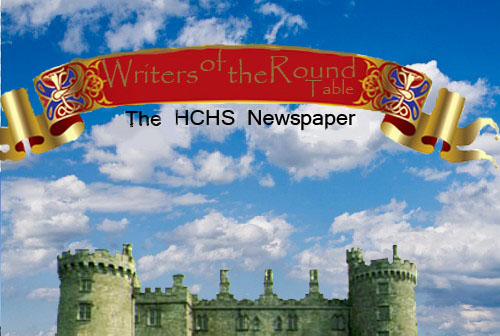Concrete poetry
By Kate Marquam
So far, we've talked about poetry with a strict syllable counts, rhyming patterns, and rhythm. But some forms of poetry have no real rules. For example, freeverse poetry. The type of poetry to be discussed today is a bit like freeverse, but with just one real rule. Today we will be discussing Concrete poetry, or as it's more commonly called, Shape poetry.
Shape poetry reflects its name- the poem is in the shape of its subject. The words can be creatively positioned in any way to give the desired effect. It plays not with how the poem sounds, but with how the poem looks on paper. For example, check out this example I did about a banjo. Look especially at how the handle of the banjo is done.
This example is quite lighthearted, using the form to bring out the imagery in the piece. Most Concrete poetry is geared towards children, but it doesn't have to be that way. The form can be used to send a powerful message. Look at the example below. I wrote it in the shape of a gun, and it is about a very serious topic, unlike the previous example.
There is a faint dusting of powder covering the tip of the
gun, and the smell of death and destruction hangs heavily
in the previously innocent air. The silence echoes in denial of
the evil deed just now done, driving steel into the core of a
perfectly clueless, innocent human being. Gone with the
easy grip formed by
black leather coated long
fingers as to not
leave any trace
of this terrible
thing that can't
ever be undone.
Both of these examples are good representations of the Shape poetry form. There is no right or wrong way to do this- rhyme, no rhyme, it doesn't matter. Typically, this form is concerned with being pleasing to the eye, and is not meant to be read aloud. Usually, it is lighthearted, but it that also is optional; I chose to do one with a darker theme. Just decide on a topic, sit down, and experiment with not only the words you choose, but the placement of the words. Whatever you do, just have fun with it. Happy penning!
By Kate Marquam
So far, we've talked about poetry with a strict syllable counts, rhyming patterns, and rhythm. But some forms of poetry have no real rules. For example, freeverse poetry. The type of poetry to be discussed today is a bit like freeverse, but with just one real rule. Today we will be discussing Concrete poetry, or as it's more commonly called, Shape poetry.
Shape poetry reflects its name- the poem is in the shape of its subject. The words can be creatively positioned in any way to give the desired effect. It plays not with how the poem sounds, but with how the poem looks on paper. For example, check out this example I did about a banjo. Look especially at how the handle of the banjo is done.
G
E
N
T
L
Y
E
N
T
L
Y
I pluck
Metal strings
Such a soft caress
And I, the magic
Maker carefully
coax out the
rich, country
sound
This example is quite lighthearted, using the form to bring out the imagery in the piece. Most Concrete poetry is geared towards children, but it doesn't have to be that way. The form can be used to send a powerful message. Look at the example below. I wrote it in the shape of a gun, and it is about a very serious topic, unlike the previous example.
There is a faint dusting of powder covering the tip of the
gun, and the smell of death and destruction hangs heavily
in the previously innocent air. The silence echoes in denial of
the evil deed just now done, driving steel into the core of a
perfectly clueless, innocent human being. Gone with the
easy grip formed by
black leather coated long
fingers as to not
leave any trace
of this terrible
thing that can't
ever be undone.
Both of these examples are good representations of the Shape poetry form. There is no right or wrong way to do this- rhyme, no rhyme, it doesn't matter. Typically, this form is concerned with being pleasing to the eye, and is not meant to be read aloud. Usually, it is lighthearted, but it that also is optional; I chose to do one with a darker theme. Just decide on a topic, sit down, and experiment with not only the words you choose, but the placement of the words. Whatever you do, just have fun with it. Happy penning!



